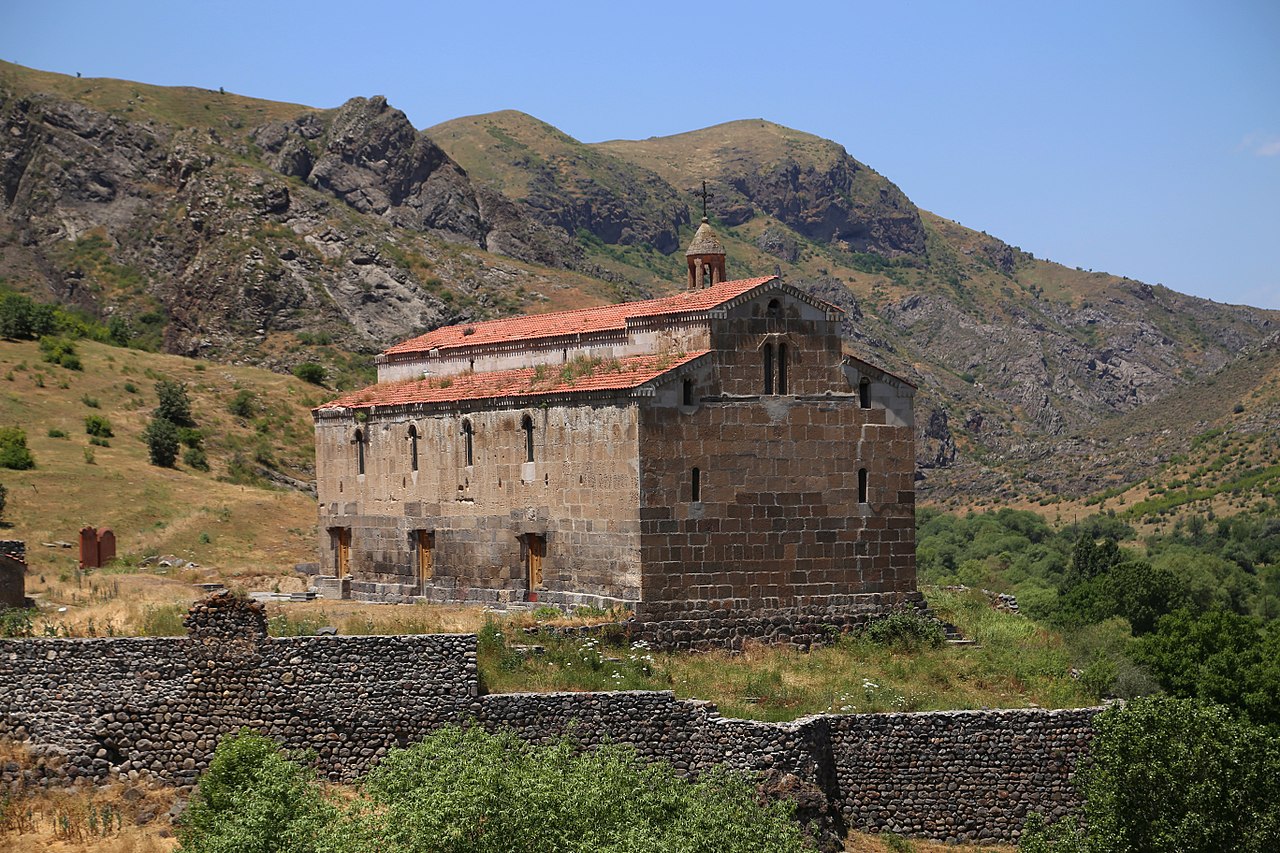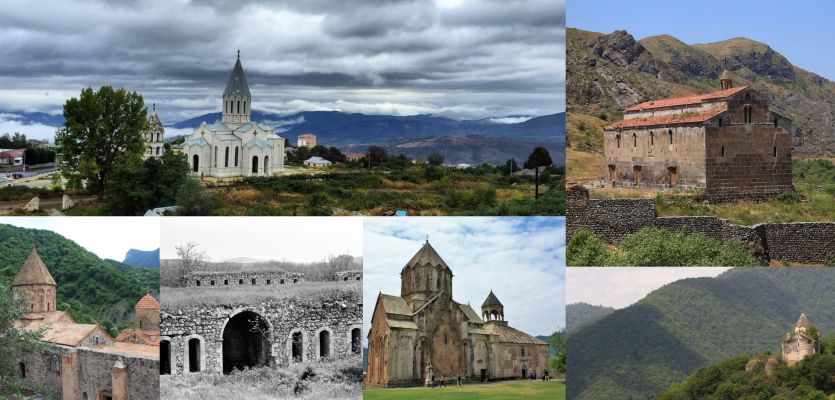A brief introduction to Artsakh's culture: Part I - Churches & monasteries
October 05, 2020
With the recent outbreak of war in Artsakh, it is now more essential than ever to learn about the history of Artsakh when trying to understand the intensifying situation. Conflicting reports are widespread, misinformation is prevalent, and individuals with suspicious motives are a constant threat in falsifying the history of Artsakh.
Through h-pem and its efforts to inspire young Armenians to learn and embrace the Armenian homeland and its culture, we provide our readers with a brief introduction into the culture of Artsakh, consisting of some essential “facts you should know.” This series is not intended to be exhaustive and we welcome any suggestions for additions you may have!
Artsakh hosts several thousand architectural artifacts and historical monuments, including samples of civil architecture, ancient castles and fortresses, as well as numerous intricate khachkars (cross-stones). The art and architecture created in Artsakh have progressed through the years, more or less on pace with Armenian art elsewhere: It began developing in the pre-Christian times, proceeded through the adoption of Christianity early in the fourth century, and entered the era of modernity after thriving in the Middle Ages.
Churches, cathedrals, chapels, and monasteries were the primary forms of art in Artsakh in the Middle Ages. According to several sources, the earliest monuments in Artsakh relate to the pre-Christian era. The most interesting and common art from the Pre-Christian era are the large anthropomorphic stone idols that are found in the eastern lowlands of the northern counties of Jraberd and Khachen from the Iron Age. Meanwhile, the northeast outskirts of the Artsakh Republic are filled with border stones (Sahmanakars). These stones originally appeared during the Artashesian dynasty rule (190 BC-53 AD) in Armenia, and continued to be placed throughout the Middle Ages.
Churches and monasteries
Amaras Monastery (St. Grigoris of the Amaras), one of the world’s oldest places of Christian worship, was built in the 4th century by St. Gregory himself (according to St. Mesrop Mashtots). In fact, while traveling in Artsakh and the neighboring provinces of Utik and Syunik, St. Mashtots established a school at Amaras, where the Armenian script was first introduced for instructional purposes. The Amaras Monastery is located near Sos in the southeast province of Martuni in the Artsakh Republic.
.png) Amaras Monastery's walls (Photo: Igor P.)
Amaras Monastery's walls (Photo: Igor P.)
 The rebuilt St. Grigoris of the Amaras (Photo: Alina Parazyan)
The rebuilt St. Grigoris of the Amaras (Photo: Alina Parazyan)
The Tzitzernavank Monastery, which today exists as a church, is an important religious site that is the best-preserved example of an Armenian basilica with three naves. It is located in Aghahechk, one of the 12 cantons of the historical Armenian province, and was completed between the 5th and 6th centuries. There are several more examples from this period but it’s important to note that Artsakh’s architecture genuinely made huge strides during the post-Seljuk period and the beginning of the Mongol period. Monasteries in this period were fortified for security purposes and served as strong centers of art and scholarship.
 Tzitzernavank Monastery (Photo: Wikimedia Commons)
Tzitzernavank Monastery (Photo: Wikimedia Commons)
Dadivank, built between the 9th and 13th centuries, is the largest monastic complex in Artsakh and all of Eastern Armenia. It is located in the northwest Republic of Artsakh, in the Martakert District and founded by St. Dadi, a disciple of Thaddeus the Apostle, who spread Christianity in Eastern Armenia during the first century AD. In July 2007, the grave of St. Dadi was discovered under the holy altar of the main church. Most recently, renovation efforts have begun to restore the monastery, its chapel, as well as the 13th-century frescos.
A well-known 13th-century monastery known for its extremely detailed dome is Gandzasar Monastery, which was built near Artsakh's Vank village. The name Gandzasar translates to “Treasure Mountain” in Armenian. It was given this name because of the traditional belief that the monastery was built on a mountain that contained ores of silver and other metal. Armenian khachkars dated to the Middle Ages have also been found at the site of the monastery. The main church in the monastery was built by Hasan-Jalal Dawla, the Armenian prince of Inner Khachen and the patriarch of the House of Hasan-Jalalyan. Throughout its history, the monastery has served as a center of education and manuscript production. Interestingly, the monastery was severely damaged during the Artsakh Liberation War in the 1990s, but was quickly renovated. The main church of Gandzasar Monastery has a rectangular, cruciform plan with two-floored chambers on four corners. The church is prominent for its richly decorated 16-sided dome. The narthex is a square-plan hall with two columns near the eastern wall that support the roof.
.png) Gandzasar Monastery (Photo: Wikimedia Commons)
Gandzasar Monastery (Photo: Wikimedia Commons)
The Yerits Mankants Monastery is a 17th-century monastery in Jraberd in Artsakh's Martakert province. Yerik Mankants Monasatry was built following a brief pause in the blossoming of church building in Artsakh in the late Middle Ages. It was financed by the Melik-Israelians feudal family (Lords of Jraberd).
 The Yerits Mankants Monastery (Photo: Wikimedia Commons)
The Yerits Mankants Monastery (Photo: Wikimedia Commons)
Ghazanchetsots, an Armenian Apostolic Church in Shushi, Artsakh, is a cathedral built in 1888 that is the current seat of the Diocese of Artsakh of the Armenian Apostolic Church. Its name comes from Ghazanchi (present-day Qazançı), a village in Nakhichevan, whose Armenian migrants financed the church's construction. The cathedral was heavily damaged during the March 1920 massacre of Armenians in Shushi by Azerbaijanis. The church was restored following the Artsakh War and has become a symbol of liberation for many Armenians. The cathedral's church is a domed basilica with four apsides. The church's floor plan is an imitation of that of Etchmiadzin Cathedral, Armenia's mother church. The church and the bell tower are also made out of white limestone. The cathedral is included in the list of cultural and historical monuments of the Artsakh Republic.
 Ghazanchetsots (Photo: Rupen Janbazian)
Ghazanchetsots (Photo: Rupen Janbazian)
Sources:
- A Brief History of the Art and Architecture of Artsakh - Nagorno Karabakh. (n.d.). Retrieved October 1, 2020, from http://www.nkrusa.org/country_profile/art_history_of_artsakh.shtml
- Dadivank. (1995). Journal of the Society for Armenian Studies, 6(7).
- Diocese of the Armenian Church of America (Eastern). (n.d.). Retrieved October 1, 2020, from http://www.armenianchurch.org/. Section: "Dioceses: Armenia"
- Hewsen, R. H., & Salvatico, C. C. (2001). Armenia: A historical atlas. Chicago, IL: University of Chicago Press.
- Karanian, M., & Kurkjian, R. (2006). The Stone Garden Guide: Armenia & Karabagh (p. 265). Los Angeles: Stone Garden Productions.
- Karapetyan, S. (2001). Tzitzernavank. In Armenian cultural monuments in the region of Karabakh. Yerevan: "Gitutiun" Publishing House of NAS RAA.
- Noble, J., Kohn, M., & Systermans, D. (2012). Georgia, Armenia & Azerbaijan. Footscray, Vic.: Lonely Planet.
Join our community and receive regular updates!
Join now!
Attention!